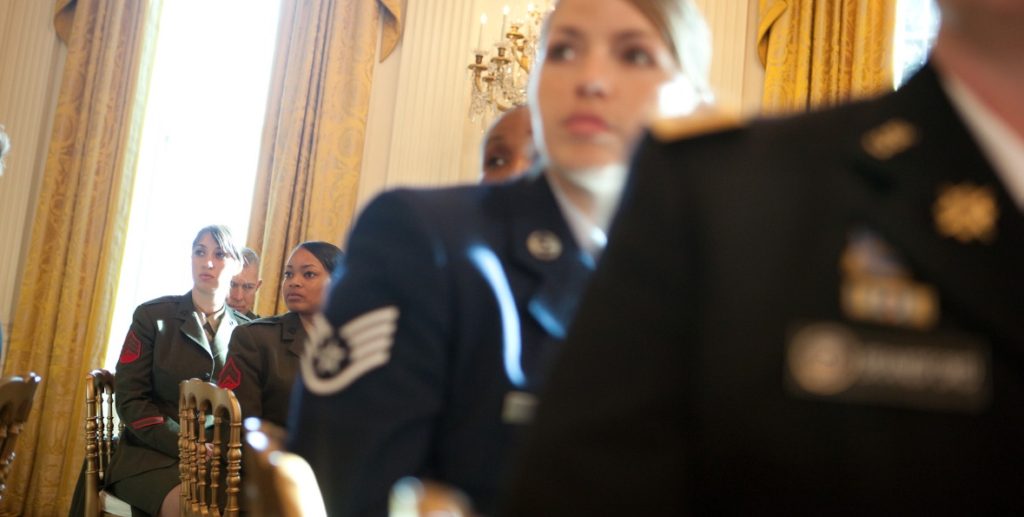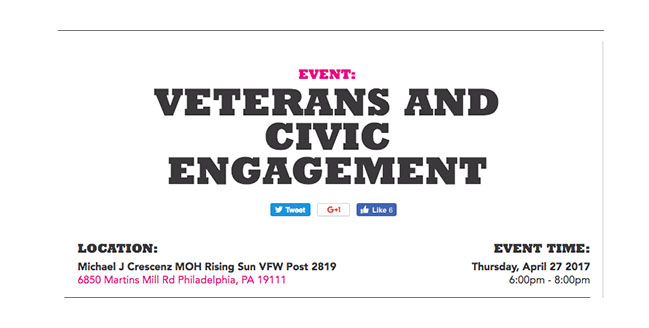When Rebekah Mellen left the Air Force in 1995, after serving for five-and-a-half years, she found herself adrift, in at least one way: How to still feel like she was engaged in something more important than herself. “When you are in the military, you are a part of something that is bigger than you,” says Mellen, “and then you spend the rest of your life trying to recapture that feeling.”
Mellen moved to Philadelphia last fall, and was looking for somewhere to volunteer when she stumbled upon the Veterans Multi-Service Center in Old City. Mellen is now a regular volunteer at the VMC and—even more importantly for her—the Women Veteran Center (WVC), an offshoot for female veterans in the city. What she has found there is both fulfillment for herself, and a community that she wishes she had experienced in those early days after she left the Air Force.
“It’s really hard to transition from military life to civilian life,” she explains. “When you are in the military, you are constantly changing locations and being plopped into communities where you feel like an outsider. The people you are in service with become your community. You understand each other. So coming to a place like WVC, you have an instant connection with each other—you have a shared history of how to be in a place.”
The Citizen and the Women Veterans Center are hosting a Citizen Town Hall on Thursday for all vets (or anyone) like Mellen, who are looking for a way to stay civically engaged after their service is over. The event, at the VFW hall near Cheltenham, will feature State Rep. (and veteran) Jared Solomon; activist and community organizer Melissa Robbins; Mantua Civic Association president Dewayne Drummond; Jack Inacker, of Global Citizen; and Stephen St.Vincent, social action coordinator of The Citizen. (More infomation and to RSVP here.)
The town hall is open to all vets. But it is part of the larger mission of the WVC, to help female vets make the difficult transition from being in the service to being at home. It launched in 2014 as an offshoot of the VMC, a space for both male and female veterans that opened in 1980 to address the needs of vets. Over the years, it became clear that female veterans have different needs than male veterans, who still dominate the conversation and the services at places like the VMC.
Women make up the fastest growing population of vets; post-9/11, their numbers have become the highest in American history. One percent of the population are veterans; 10 percent of that one percent are women.
“A defined ‘separate’ space is incredibly important as some women veterans may not otherwise seek the help they need or feel comfortable opening up in a male-dominated setting,” says Lincoln Strehle, Deputy Executive Director of the Veterans Multi-Service Center. “VMC was determined to break down that barrier, and the Women Veterans Center was established for all women veterans to come and seek the services they truly deserve in a comfortable setting.”
Some of that is out of emotional need: 1 in 6 female vets report being sexually assaulted during their service, and many suffer from PTSD. For them, male-dominated vet centers can be more traumatizing than comforting. But the WVC—which accommodates veterans and their families from Korea to post-9-11—is also about empowerment.
Women veterans are underrecognized—and when they are they are often represented as downtrodden women whom society should feel bad for because they have been sexually assaulted. The truth is that the number of women serving in the military is growing and they are now working in jobs within the military where they weren’t previously allowed, such as on the front line in combat roles. WVC is creating a “space where women can thrive,” says Anna Stormer, Coordinator of the WVC.
“It’s really hard to transition from military life to civilian life,” she explains. “When you are in the military, you are constantly changing locations and being plopped into communities where you feel like an outsider. The people you are in service with become your community. You understand each other. So coming to a place like WVC, you have an instant connection with each other—you have a shared history of how to be in a place.”
On one of their monthly fellowship dinners recently, the women passed around fresh fruit and chicken salad, then stood up and pushed the long rectangular tables to the side of the room so that one of them could take the stage. Part of a traveling singing group that performs oldies covers, she belted Teddy Pendergrass songs, while her friends sang along and clapped to the rhythm of her voice. After, they retired to the communal couches like a post-Thanksgiving meal with family, sharing stories of getting into college, newly born grandchildren, and lost loves.
“It was this beautiful moment where everyone was chiming in about different moments in their life and sharing stories of when they went through those moments,” describes Stormer.
It’s these beautiful women-centric moments that the WVC is all about. The soft blue walls are lined with pictures and artwork of smart, strong women. There’s a lending library, a free clothing store, and a children’s play area. Besides the monthly dinners, there are cooking classes, park days with children and grandchildren, and drop in hours on Tuesday and Thursday where women can come use the computer, print their resume, or just hang out. They come and go as they please, kids in tow or just solo.
“We are really trying to make sure the woman feel a sense of fellowship and connectedness. That’s what I’m going for,” explains Stormer. “We are working to figure out how to meet everyone’s needs since they may be different among generations.”
Since it’s inception, over 500 women and their families have come to the space for benefits counseling, traditional services offered by most VA centers. They help women get financial resources, job training and placement, rapid re-housing, and meals twice-a-day. There is a case manager who comes to work with the women from the main VMC should they need one-on-one support. (A full list of VMC services is here.)
“We don’t want the space to feel clinical at all so we let one-on-one relationships happen naturally,” explains Stormer. As a program of the larger VMC organization, the WVC is funded by the Veterans Multi-Service Center, and then supplemented through grants from Veterans Trust Fund (Pennsylvania Department of Military, Veterans Affairs (DMVA), and the Austelle Foundation.
The WVC is the first women’s veterans center Mellen has come across since her return to civilian life. She says she wishes she’d had a space like it to deal with her emotional needs upon returning. “I have been there on days when women come in just to talk and on days when women really need help. I mean something which seems so basic like transitioning a military resume to a civilian resume is tough.”
At the Women’s Veteran Center, you don’t have to explain yourself. You can just be, and be part of a community of women who understand. Stormer, who is not a vet herself, ensures this with her energy, and willingness to learn from her clients. As I was walking out of the WVC a few weeks ago, I commented on the fact that they had two refrigerators.
Stormer nodded. “Yea, when I started here, there was a staff refrigerator and a client refrigerator,” she said. “I just didn’t like that. So I took the signs off and made them all the same. If someone wants some of my mac and cheese, have some of my mac and cheese!”
Correction: An earlier version of this story misstated the length of timeRebekah Mellen served in the Air Force. It was five-and-a-half years. She was honorably discharged due to pregnancy.


